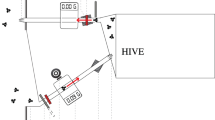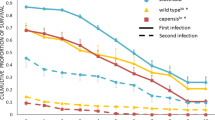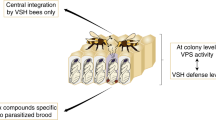Abstract
THE giant hornet Vespa mandarinia japonica (Hymenoptera: Vespidae) is the only hornet species known to have evolved en masse predation of other social bees and wasps. Here we show that hornets is initiated by secretion of a foraging-site marking pheromone from the van der Vecht glands (metasomal sternum VI glands) by a single foraging hornet. The lone hornet rubs the basal tuft of the terminal gastral sternite around a prey food resource, such as a honeybee colony, and the hornet nestmates then congregate and attack the marked site en masse. The sympatric Japanese honeybee Apis cerana japonica (Hymenoptera: Apidae) can detect the hornet marking pheronome, and responds by increasing the number of defenders at the nest entrance. When an invading hornet is captured by a defending bee, more than 500 other bees quickly engulf the hornet in a ball which contains isoamyl acetate. Thermography showed that the ball temperature is very high (˜47 °C), which proves lethal to the hornet but not to the bees. Defenders patrolling the nest entrance also generate high temperatures. These findings suggest that aspects of the interaction between V. mandarinia japonica and A. cerana japonica are specifically coevolved.
This is a preview of subscription content, access via your institution
Access options
Subscribe to this journal
Receive 51 print issues and online access
$199.00 per year
only $3.90 per issue
Buy this article
- Purchase on Springer Link
- Instant access to full article PDF
Prices may be subject to local taxes which are calculated during checkout
Similar content being viewed by others
References
Okada, I. Bull. Fac. Agr. Tamagawa Univ. 2, 73–89 (1961) (in Japanese with English summary).
Matsuura, M. & Sakagami, S. F. J. Fac. Sci. Hokkaido Univ. VI Zool. 9, 125–162 (1973).
Jeanne, R. L. Science 168, 1465–1466 (1970).
Kojima, J. Insectes soc. 40, 403–421 (1993).
Ono, M., Okada, I. & Sasaki, M. Experientia 43, 1031–1032 (1987).
Free, J. B. Pheromones of Social Bees (Chapman & Hall, London, 1987).
Wilson, E. O. Science 190, 798–800 (1975).
Wilson, E. O. Behav. Ecol. Sociobiol. 1, 63–81 (1976).
Stabentheiner, A. in The Behaviour and Physiology of Bees (eds Goodman, L. J. & Fisher, R. C.) 89–101 (CAB International, Wallingford, 1991).
Author information
Authors and Affiliations
Rights and permissions
About this article
Cite this article
Ono, M., Igarashi, T., Ohno, E. et al. Unusual thermal defence by a honeybee against mass attack by hornets . Nature 377, 334–336 (1995). https://doi.org/10.1038/377334a0
Received:
Accepted:
Issue Date:
DOI: https://doi.org/10.1038/377334a0
This article is cited by
-
Genes associated with hot defensive bee ball in the Japanese honeybee, Apis cerana japonica
BMC Ecology and Evolution (2022)
-
Multi-level instrumentation of bivouac thermoregulation: current methods and future directions
Artificial Life and Robotics (2022)
-
Interspecific variation of antennal lobe composition among four hornet species
Scientific Reports (2021)
-
Infrared thermography for insect detection: lighting up the spotted lanternfly in the field
Journal of Pest Science (2021)
-
Interaction between Vespula germanica and Apis mellifera in Patagonia Argentina apiaries
Apidologie (2021)
Comments
By submitting a comment you agree to abide by our Terms and Community Guidelines. If you find something abusive or that does not comply with our terms or guidelines please flag it as inappropriate.



